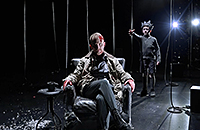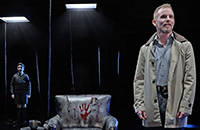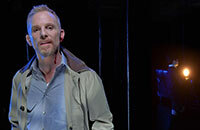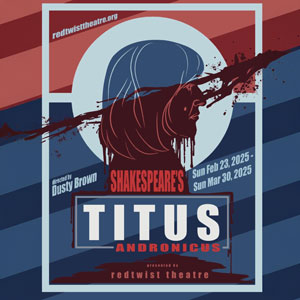
 ****Four Stars! What do you get when you merge elements of Shakespeare’s Macbeth with the narrative structure of “I, Claudius”? You get “I, Banquo”, a theatrical film that approaches the classic tale through the perspective of Banquo, Macbeth’s once close friend, confidante, and comrade-in-arms. Lovers of Shakespeare who are already acquainted with the story of Macbeth will greatly enjoy watching this supremely imaginative psychological portrait via the internet. Written by Tim Crouch, Banquo’s first-person account doubles as his life-review from a dark, indeterminate location, presumably the state of limbo. Deeply tormented by the betrayal by a man whom he thought he knew so well, Banquo reflects on his own fate and that of his family, focusing on the three weird sisters who foretold improbable life events. We see his angst when he tells us how he was blindsided by the plot that Macbeth and his wife had hatched to murder Duncan I, King of Scotland and to install himself as King. It is as if the audience serves as Banquo’s Father Confessor: We commiserate with him for his misplaced trust and witness how he processes the trauma of his physical and psychological death. But in the end, karma rules: Banquo’s ultimate revenge for having been murdered is that his progeny will ascend to the throne of Scotland, and, as he explains, all of them are parts of himself. And as for Macbeth’s ultimate fate beyond the grave? The audience can only guess what God’s judgment might be.
****Four Stars! What do you get when you merge elements of Shakespeare’s Macbeth with the narrative structure of “I, Claudius”? You get “I, Banquo”, a theatrical film that approaches the classic tale through the perspective of Banquo, Macbeth’s once close friend, confidante, and comrade-in-arms. Lovers of Shakespeare who are already acquainted with the story of Macbeth will greatly enjoy watching this supremely imaginative psychological portrait via the internet. Written by Tim Crouch, Banquo’s first-person account doubles as his life-review from a dark, indeterminate location, presumably the state of limbo. Deeply tormented by the betrayal by a man whom he thought he knew so well, Banquo reflects on his own fate and that of his family, focusing on the three weird sisters who foretold improbable life events. We see his angst when he tells us how he was blindsided by the plot that Macbeth and his wife had hatched to murder Duncan I, King of Scotland and to install himself as King. It is as if the audience serves as Banquo’s Father Confessor: We commiserate with him for his misplaced trust and witness how he processes the trauma of his physical and psychological death. But in the end, karma rules: Banquo’s ultimate revenge for having been murdered is that his progeny will ascend to the throne of Scotland, and, as he explains, all of them are parts of himself. And as for Macbeth’s ultimate fate beyond the grave? The audience can only guess what God’s judgment might be.
Dan Waller, in a brilliantly emoted performance, plays Banquo and is joined from time to time by Patrick Scott McDermott in the role of Banquo’s son Fleance. This two-character show is finely directed and choreographed by Marti Lyons, who blends in all the components integral to an excellent online video production. Scenic design by Yu Shibagaki combined with lighting design by Jason Lynch could not have been done any better. At first glance, the overall stage is simple, but it is highly effective: Black curtains interposed with voids add to the mysteriousness of life and death and the unflagging balance between free will and predestination. The flashing, pulsing, and systemic triggering of white lamps constantly punctuate the darkness, representing the light of truth and piercing revelations that occasionally unmask the unknown and the unknowable. Sound design and composition by Mikhail Fiksel embellish the hauntingness inherent in the tale. Costume design by Raquel Adorno is perfect; Banquo’s modern suit is both neutral and gray, a palette which plays up the grayness of the man’s uncertain destiny, whereas Fleance’s period costume indicates that he is much alive during Banquo’s post hoc retelling. Video design by Mike Tutaj captures the display marvelously for the small screen, with curious camera angles and precise switching that add depth to this one-take performance. This exceptional video design injects elements that convey mood and add tension, well beyond a more traditional approach, where camera movement tends to fade into the background. By using remote-controlled cameras and a virtual command center, the team did a phenomenal job filming a live show and working at a safe distance in the theater as well as remotely across multiple time zones—a nod to COVID-19’s effect on current production protocols.
Ingenious imagery regales, particularly the gray chair with the bloody handprint that advertises the show. This handprint is the mirror image of the one on Banquo’s back, which symbolically represents murder by a friend turned foe, by an attacker physically and socially close enough to his victim. The stunning graphic adroitly parallels the imperfect mirror in Crouch’s script of ancient Rome, an allusion to assassinations in Roman times, such as that of Julius Caesar in 44 AD and Caligula in 41 AD, and to stories recounted “autobiographically” by Claudius in Robert Graves’s historical novel I, Claudius (1934). The sad takeaway is that this bloody history of politics, power, war, privilege, and revenge repeats itself from one era to the next and is apparently part of the human condition on earth, regardless of whether the author is Shakespeare, Graves, Crouch, or God Almighty.
At one of the crucial plot points when various lights flicker on stage, I heard what seemed to be the soft yet blaring sound of a car alarm in the distance. I didn’t know if this was part of the sound design or was occurring in real time. So I paused the video stream on my home computer, and sure enough, the sound was emanating from somewhere outside my building. But the timing was so perfect that I cannot fail to comment about it here. Just like seeing Banquo in modern dress, the accidental incorporation of this modern sound added yet another facet to the presentation.
In all, the show is excellent and its technical aspects superior. Nevertheless, I would recommend that the audience familiarize itself with Shakespeare’s classic—and possibly with “I Claudius” as well—so as to truly savor the beauty of the performance and appreciate the deeper meanings throughout.
 “I, Banquo” is a production of Chicago Shakes Stream and is available for viewing on demand on streaming video via the Chicago Shakespeare Theater’s website through April 18, 2021.
“I, Banquo” is a production of Chicago Shakes Stream and is available for viewing on demand on streaming video via the Chicago Shakespeare Theater’s website through April 18, 2021.
Streaming is $25 per single view.
For tickets and more information about this show and for the full list of others in the online video series, please go to https://www.chicagoshakes.com/plays_and_events/explore_season/stream.
For special access needs or additional assistance, please contact the Box Office at 312-595-5600 during regular business hours: 12 noon -4 p.m. on Tuesdays through Saturdays.
For general information about Chicago Shakespeare Theater on Navy Pier or to make a donation, please visit their website: www.ChicagoShakes.com.
To see what others are saying, visit www.theatreinchicago.com, go to Review Round-Up and click at “I,Banquo”






More Stories
“February House” reviewed by Julia W. Rath
” A Lie of The Mind”
“Titus Andronicus”